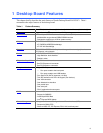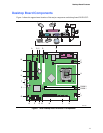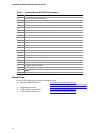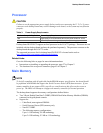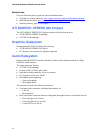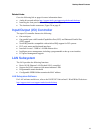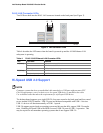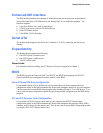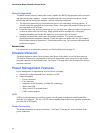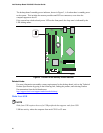Desktop Board Features
17
Enhanced IDE Interface
The IDE interface handles the exchange of information between the processor and peripheral
devices like hard disks, CD-ROM drives, and Iomega Zip* drives inside the computer. The
interface supports:
• Up to four IDE devices (such as hard drives)
• ATAPI-style devices (such as CD-ROM drives)
• Older PIO Mode devices
• Ultra DMA-33/66/100 modes
Serial ATA
The desktop board supports four Serial ATA channels (1.5 Gb/s), connecting one device per
channel.
Expandability
The desktop board supports the following:
• One PCI Express x16 add-in card
• One PCI Express x1 add-in card
• Two PCI add-in cards
Related Links:
For information about installing the PCI Express x16 card, see page
34 in Chapter 2.
BIOS
The BIOS provides the Power-On Self-Test (POST), the BIOS Setup program, the PCI/PCI
Express and IDE auto-configuration utilities, and the video BIOS.
Serial ATA and IDE Auto Configuration
If you install a Serial ATA or IDE device (such as a hard drive) in your computer, the auto-
configuration utility in the BIOS automatically detects and configures the device for your computer.
You do not need to run the BIOS Setup program after installing a Serial ATA or IDE device. You
can override the auto-configuration options by specifying manual configuration in the BIOS Setup
program.
PCI and PCI Express* Auto Configuration
If you install a PCI/PCI Express add-in card in your computer, the PCI/PCI Express auto-
configuration utility in the BIOS automatically detects and configures the resources (IRQs, DMA
channels, and I/O space) for that add-in card. You do not need to run the BIOS Setup program after
you install a PCI or PCI Express add-in card.



